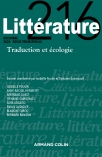
Romantisme n° 136 (2/2007)
Pour acheter ce numéro, contactez-nous
Recevez les numéros de l'année en cours et accédez à l'intégralité des articles en ligne.
La Comédie humaine s’invente dans le temps où s’édifient les premiers réseaux de chemins de fer. Comme Balzac a l’ambition de corriger le « défaut de liaison » du roman en faisant revenir ses personnages, les nouveaux moyens de transport portent avec eux l’espoir de réparer les injustices géologiques, de décloisonner le monde et d’inventer ainsi une conscience planétaire. En confrontant les discours de figures du libéralisme comme Lamartine ou Renan et la composition d’oeuvres comme La Comédie humaine ou Les Hommes de bonne volonté, le cycle romanesque – et l’effet esthétique qui lui est propre : la distance interne reconfigurante – nous apparaît comme une façon de penser la complexité nouvelle d’un monde où l’ici ne peut plus oublier ses ailleurs.
Balzac wrote The Human Comedy when the first railway networks were forming across Europe. Just as Balzac hoped to remedy the “lack of connectedness” in the novel by having his characters reappear periodically, the new modes of transportation were conceived as a way to correct geological accidents, to decompartmentalize the world, and thus to invent a world-wide consciousness. From a confrontation of the oratorical practice of such great figures of nineteenth-century liberalism as Lamartine and Renan and composition techniques used by Balzac, Proust, or Jules Romains in their fictions, one may argue that novelistic cycles produce in the readers’ minds a feeling of “internal distance” with reconfiguring consequences and that this specific aesthetic effect is a way of making sense of the new complexity of a world in which one can no longer conceive of “here” in isolation from a “there”– i.e. from elsewhere.

